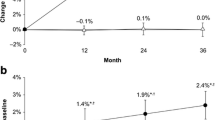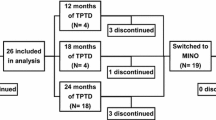Abstract
Risedronate is used in osteoporosis treatment. Postmenopausal women enrolled in the Vertebral Efficacy with Risedronate Therapy trial received either risedronate (5 mg/day) or placebo for 3 years. Subjects received calcium and vitamin D supplementation if deficient at baseline. Lumbar spine bone mineral density (BMD) was measured at baseline and at 3 years. Quantitative back-scattered electron imaging (qBEI) was performed on paired iliac crest biopsies (risedronate, n = 18; placebo, n = 13) before and after treatment, and the mineral volume fraction in the trabecular bone was calculated. Combining dual-energy X-ray absorptiometric values with the mineral volume fraction for the same patients allowed us to calculate the relative change in trabecular bone volume with treatment. This showed that the effect on BMD was likely to be due partly to changes in matrix mineralization and partly due to changes in bone volume. After treatment, trabecular bone volume in the lumbar spine tended to increase in the risedronate group (+2.4%, nonsignificant) but there was a significant decrease (−3.7%, P < 0.05) in the placebo group. Calcium supplementation with adequate levels of vitamin D led to an ∼3.3% increase in mineral content in the bone material independently of risedronate treatment. This increase was larger in patients with lower matrix mineralization at baseline and likely resulted from correction of calcium/vitamin D deficiency as well as from reduced bone remodeling. Combining BMD and bone mineralization density distribution data show that in postmenopausal osteoporosis 3-year treatment with risedronate preserves or may increase trabecular bone volume, unlike placebo. This analysis also allows, for the first time, separation of the contributions of bone volume and matrix mineralization to the increase in BMD.




Similar content being viewed by others
References
NIH (2001) NIH Consensus Development Panel on Osteoporosis Prevention, Diagnosis, and Therapy, March 7–29, 2000. Highlights of the conference. South Med J 94:569–573
McClung M (2003) Use of highly potent bisphosphonates in the treatment of osteoporosis. Curr Osteoporos Rep 1:116–122
Epstein S (2005) The roles of bone mineral density, bone turnover, and other properties in reducing fracture risk during antiresorptive therapy. Mayo Clin Proc 80:379–388
Bjarnason NH, Sarkar S, Duong T, Mitlak B, Delmas PD, Christiansen C (2001) Six and twelve month changes in bone turnover are related to reduction in vertebral fracture risk during 3 years of raloxifene treatment in postmenopausal osteoporosis. Osteoporos Int 12:922–930
Eastell R, Barton I, Hannon RA, Chines A, Garnero P, Delmas PD (2003) Relationship of early changes in bone resorption to the reduction in fracture risk with risedronate. J Bone Miner Res 18:1051–1056
Bauer DC, Black DM, Garnero P, Hochberg M, Ott S, Orloff J, Thompson DE, Ewing SK, Delmas PD (2004) Change in bone turnover and hip, non-spine, and vertebral fracture in alendronate-treated women: the fracture intervention trial. J Bone Miner Res 19:1250–1258
Delmas PD, Seeman E (2004) Changes in bone mineral density explain little of the reduction in vertebral or nonvertebral fracture risk with anti-resorptive therapy. Bone 34:599–604
Watts NB, Cooper C, Lindsay R, Eastell R, Manhart MD, Barton IP, van Staa TP, Adachi JD (2004) Relationship between changes in bone mineral density and vertebral fracture risk associated with risedronate: greater increases in bone mineral density do not relate to greater decreases in fracture risk. J Clin Densitom 7:255–261
Miller PD, Hochberg MC, Wehren LE, Ross PD, Wasnich RD (2005) How useful are measures of BMD and bone turnover? Curr Med Res Opin 21:545–554
Watts NB, Geusens P, Barton IP, Felsenberg D (2005) Relationship between changes in BMD and nonvertebral fracture incidence associated with risedronate: reduction in risk of nonvertebral fracture is not related to change in BMD. J Bone Miner Res 20:2097–2104
Miller PD, McClung M (1996) Prediction of fracture risk. I: Bone density. Am J Med Sci 312:257–259
Fratzl P, Gupta H, Paschalis E, Roschger P (2004) Structure and mechanical quality of the collagen-mineral nano-composite in bone. J Mater Chem 14:2115–2123
Roschger P, Fratzl P, Eschberger J, Klaushofer K (1998) Validation of quantitative backscattered electron imaging for the measurement of mineral density distribution in human bone biopsies. Bone 23:319–326
Currey JD (2002) Bones - Structure and Mechanics. Princeton University Press, Princeton
Misof BM, Roschger P, Cosman F, Kurland ES, Tesch W, Messmer P, Dempster DW, Nieves J, Shane E, Fratzl P, Klaushofer K, Bilezikian J, Lindsay R (2003) Effects of intermittent parathyroid hormone administration on bone mineralization density in iliac crest biopsies from patients with osteoporosis: a paired study before and after treatment. J Clin Endocrinol Metab 88:1150–1156
Roschger P, Gupta HS, Berzlanovich A, Ittner G, Dempster DW, Fratzl P, Cosman F, Parisien M, Lindsay R, Nieves JW, Klaushofer K (2003) Constant mineralization density distribution in cancellous human bone. Bone 32:316–323
Kanis JA (2000) An update on the diagnosis of osteoporosis. Curr Rheumatol Rep 2:62–66
Cann CE (1988) Quantitative CT for determination of bone mineral density: a review. Radiology 166:509–522
Boyde A, Maconnachie E, Reid SA, Delling G, Mundy GR (1986) Scanning electron microscopy in bone pathology: review of methods, potential and applications. Scanning Electron Microsc Pt 4:1537–1554
Roschger P, Plenk H Jr, Klaushofer K, Eschberger J (1995) A new scanning electron microscopy approach to the quantification of bone mineral distribution: backscattered electron image grey-levels correlated to calcium K alpha-line intensities. Scanning Microsc 9:75–88
Eschberger J, Eschberger D (1986) Microradiography. In: Von Recum AF (ed) Handbook of biomaterials evaluation. Macmillan, New York, pp 461–500
Boivin G, Meunier PJ (2002) The degree of mineralization of bone tissue measured by computerized quantitative contact microradiography. Calcif Tissue Int 70:503–511
Zizak I, Roschger P, Paris O, Misof BM, Berzlanovich A, Bernstorff S, Amenitsch H, Klaushofer K, Fratzl P (2003) Characteristics of mineral particles in the human bone/cartilage interface. J Struct Biol 141:208–217
Harris ST, Watts NB, Genant HK, McKeever CD, Hangartner T, Keller M, Chesnut CH 3rd, Brown J, Eriksen EF, Hoseyni MS, Axelrod DW, Miller PD (1999) Effects of risedronate treatment on vertebral and nonvertebral fractures in women with postmenopausal osteoporosis: a randomized controlled trial. Vertebral Efficacy with Risedronate Therapy (VERT) Study Group. JAMA 282:1344–1352
Zoehrer R, Roschger P, Paschalis EP, Hofstaetter JG, Durchschlag E, Fratzl P, Phipps R, Klaushofer K (2006) Effects of 3- and 5-year treatment with risedronate on bone mineralization density distribution in triple biopsies of the iliac crest in postmenopausal women. J Bone Miner Res 21:1106–1112
Borah B, Dufresne TE, Ritman EL, Jorgensen SM, Liu S, Chmielewski PA, Phipps RJ, Zhou X, Sibonga JD, Turner RT (2006) Long-term risedronate treatment normalizes mineralization and continues to preserve trabecular architecture: sequential triple biopsy studies with micro-computed tomography. Bone 39:345–352
Eriksen EF, Melsen F, Sod E, Barton I, Chines A (2002) Effects of long-term risedronate on bone quality and bone turnover in women with postmenopausal osteoporosis. Bone 31:620–625
Fogelman I, Ribot C, Smith R, Ethgen D, Sod E, Reginster JY (2000) Risedronate reverses bone loss in postmenopausal women with low bone mass: results from a multinational, double-blind, placebo-controlled trial. BMD-MN Study Group. J Clin Endocrinol Metab 85:1895–1900
Qin L, Raggatt LJ, Partridge NC (2004) Parathyroid hormone: a double-edged sword for bone metabolism. Trends Endocrinol Metab 15:60–65
Whitfield JF, Morley P, Willick GE (2002) Parathyroid hormone, its fragments and their analogs for the treatment of osteoporosis. Treat Endocrinol 1:175–190
Reginster J, Minne HW, Sorensen OH, Hooper M, Roux C, Brandi ML, Lund B, Ethgen D, Pack S, Roumagnac I, Eastell R (2000) Randomized trial of the effects of risedronate on vertebral fractures in women with established postmenopausal osteoporosis. Vertebral Efficacy with Risedronate Therapy (VERT) Study Group. Osteoporos Int 11:83–91
Black DM, Greenspan SL, Ensrud KE, Palermo L, McGowan JA, Lang TF, Garnero P, Bouxsein ML, Bilezikian JP, Rosen CJ (2003) The effects of parathyroid hormone and alendronate alone or in combination in postmenopausal osteoporosis. N Engl J Med 349:1207–1215
McClung MR, San Martin J, Miller PD, Civitelli R, Bandeira F, Omizo M, Donley DW, Dalsky GP, Eriksen EF (2005) Opposite bone remodeling effects of teriparatide and alendronate in increasing bone mass. Arch Intern Med 165:1762–1768
Parisien MV, McMahon D, Pushparaj N, Dempster DW (1988) Trabecular architecture in iliac crest bone biopsies: infra-individual variability in structural parameters and changes with age. Bone 9:289–295
Jager I, Fratzl P (2000) Mineralized collagen fibrils: a mechanical model with a staggered arrangement of mineral particles. Biophys J 79:1737–1746
Gao H, Ji B, Jager IL, Arzt E, Fratzl P (2003) Materials become insensitive to flaws at nanoscale: lessons from nature. Proc Natl Acad Sci USA 100:5597–5600
Gibson LA, MF. (1999) Cellular Solids, Structure and Properties. Cambridge University Press, Cambridge
Currey JD (1999) The design of mineralised hard tissues for their mechanical functions. J Exp Biol 202:3285–3294
Roschger P, Fratzl P, Klaushofer K, Rodan G (1997) Mineralization of cancellous bone after alendronate and sodium fluoride treatment: a quantitative backscattered electron imaging study on minipig ribs. Bone 20:393–397
Roschger P, Rinnerthaler S, Yates J, Rodan GA, Fratzl P, Klaushofer K (2001) Alendronate increases degree and uniformity of mineralization in cancellous bone and decreases the porosity in cortical bone of osteoporotic women. Bone 29:185–191
Acknowledgement
We thank Gerda Dinst, Sabrina Thon, and Daniela Gabriel (Bone Material Laboratory of the Ludwig Boltzmann Institute of Osteology, Vienna, Austria) for the sample preparation. This work was supported in part by the FWF—Fonds zur Förderung der wissenschaftlichen Forschung (Austrian Science Fund) (grant P16880-B13) and by a research grant from The Alliance for Better Bone Health. Support was also received from the Austrian Social Insurance for Occupational Risk and the Social Health Insurance Vienna.
Author information
Authors and Affiliations
Corresponding author
Rights and permissions
About this article
Cite this article
Fratzl, P., Roschger, P., Fratzl-Zelman, N. et al. Evidence that Treatment with Risedronate in Women with Postmenopausal Osteoporosis Affects Bone Mineralization and Bone Volume. Calcif Tissue Int 81, 73–80 (2007). https://doi.org/10.1007/s00223-007-9039-8
Published:
Issue Date:
DOI: https://doi.org/10.1007/s00223-007-9039-8




